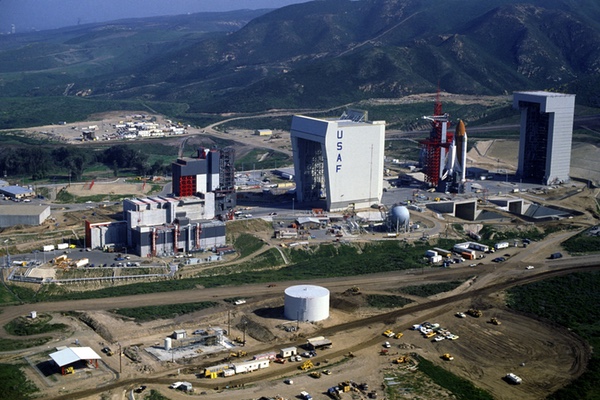Black ops and the shuttle (part 2): Reconnaissance missions in the space shuttle, from WASP to ZEUSby Dwayne Day
|
| They determined that this could be done for 20 percent of the cost of a new satellite. Next to this assertion in the report an NRO official had handwritten the word “BULL” in all caps. |
The public would not have known it was called ZEUS. And in fact, the name probably would have been changed if the program had ever become operational. ZEUS was a late 1970s plan by the secretive National Reconnaissance Office, which operated the United States’ highly classified intelligence satellites, to mount a powerful camera system inside the shuttle’s payload bay and launch out of Vandenberg perhaps four times a year. One variant of ZEUS would have operated from the payload bay during a shuttle mission lasting up to three weeks, whereas a later version would have been deployed into low Earth orbit in groups of three hockey-puck shaped satellites, which might have been serviced in orbit on following flights. If it had been given the go-ahead, perhaps a majority of the shuttle launches from California would have carried ZEUS payloads into orbit.
But ZEUS never got to fly, the space shuttle never launched from Vandenberg, and the local communities never got to bask in the glory of a space shuttle rising on pillars of flame over the mountains of the Pacific Coast.
The reusable Big Bird
The first KH-9 HEXAGON search reconnaissance satellite had roared out of Vandenberg in 1971 atop a Titan IIID, the most powerful rocket then in the Air Force’s stable. The satellite was the largest ever launched there, and pad workers had given it the nickname “the big bird.” In 1973, a team of contractors that built the HEXAGON performed a study on launching that satellite from the space shuttle (see “Black ops and the shuttle (part 1): On-orbit servicing and recovery of the HEXAGON reconnaissance satellite,” The Space Review, February 13, 2017). HEXAGON had worked well on its first mission, returning large amounts of film covering the Soviet Union and other countries. It was a highly-capable addition to the American intelligence satellite fleet. But the shuttle offered even greater capability. It had a larger payload bay and could lift heavier payloads, and had the ability to service and recover spacecraft in orbit.
HEXAGON contractors Perkin-Elmer, Lockheed, and Kodak looked at a number of options, including servicing a HEXAGON in orbit, replacing its film and reentry vehicles and other consumables such as fuel, and building larger satellites to take advantage of the shuttle’s mass and volume advantages. They ultimately concluded that the best approach would be to use the shuttle to recover the bus-sized HEXAGON and return it to the ground where it could be refurbished and relaunched. They determined that this could be done for 20 percent of the cost of a new satellite. Next to this assertion in the report an NRO official had handwritten the word “BULL” in all caps.
The skepticism within the NRO about messing with the HEXAGON design continued throughout the 1970s. In April 1975, Raymond E. Anderson, who ran the West Coast-based office in charge of HEXAGON, wrote a memo about a recent transition plan for using the space shuttle. He believed that the plan had underestimated how to deal with the HEXAGON and suggested that in the future it would be better if his office was involved from the start.
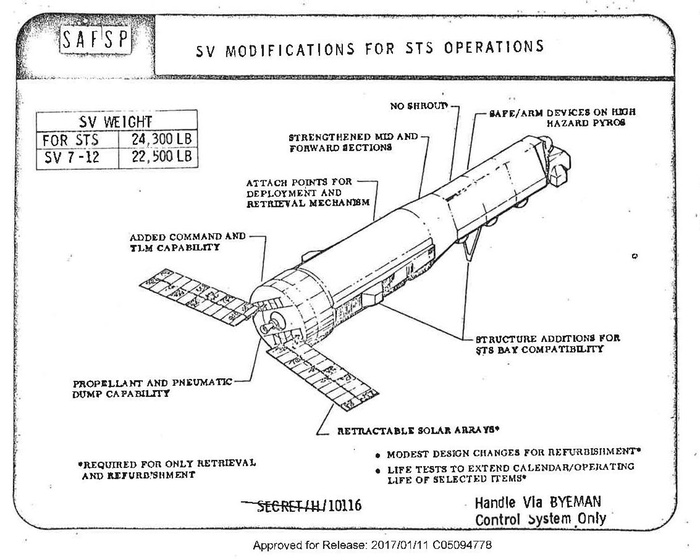 |
Anderson also expressed some annoyance with the 1973 study of modifying the HEXAGON for the shuttle, which had not been conducted by his office but rather by the NRO’s West Coast advanced systems office, known as “Special Projects office 6,” or “SP-6” for short. Naturally, as the head of SP-7, the office that oversaw the HEXAGON, Anderson did not like that another office was studying how to use it on the shuttle. “Despite the conclusions drawn by my contractors in the past Shuttle studies conducted by SP-6,” Anderson wrote, “I feel the most useful way for HEXAGON to use the shuttle is to replenish the expendables in orbit.” The contractors had determined that this would be too complicated, but Anderson had his own reasoning: “I sure don’t want to bring it back to let the contractors tear it apart and rebuild it,” he wrote.
HEXAGON had been started in 1966 to replace the CORONA search satellite, whose mission was to photograph large swaths of the Soviet Union looking for changes and new activity. HEXAGON had more powerful cameras, much more film, a greater lifetime in orbit, and four reentry vehicles compared to CORONA’s two. The spacecraft was tremendously capable. But this also made it an attractive target. By the early 1970s, the Soviet Union had begun testing an anti-satellite weapon system, and this emerging threat made NRO officials worry about the vulnerability of their satellites. Starting in the mid-1970s, the NRO began studying simpler wide-area search systems, exploring how to make such systems more survivable. One of the possible solutions was replacing the single large HEXAGON spacecraft with more, smaller satellite vehicles, creating more, smaller, targets.
According to newly-declassified documents on NRO policy toward using the space shuttle, NRO officials made several decisions in 1975. The first and most important was that they would not modify any of their spacecraft then in production, such as HEXAGON, to take advantage of the shuttle’s particular attributes. NRO policy was that:
- Interfaces between shuttle and NRO payload to be kept as simple as possible;
- Use the shuttle only as a booster;
- Retain expendable launch vehicle capability until shuttle demonstrates reliability and weight carrying ability.
| Mark had been at NASA, and he was a shuttle advocate. By 1978, the NRO changed its policy toward the shuttle. |
By 1975, NRO officials had also decided to launch one HEXAGON per year through 1984 and to replace it by 1984 or 1985. That meant that a replacement had to be started by 1979. There also appears to have been a conclusion within the intelligence community that HEXAGON was more capable than needed for the search mission, and any replacement system could have slightly lower resolution. But the shuttle provided other options as well, and some NRO officials were eager to investigate them. Soon they got their chance.
In August 1977, Hans Mark became director of the National Reconnaissance Office. Mark had been at NASA, and he was a shuttle advocate. By 1978, the NRO changed its policy toward the shuttle. The new NRO policy declared:
- Fully exploit the unique capabilities of the shuttle to enhance NRO missions;
- Expendable launch vehicle strategy keyed to shuttle performance milestones;
- Transition all spacecraft to shuttle as soon as prudent risk judgments and cost factors permit.
WASP
The NRO decided against following Anderson’s advice about servicing HEXAGONs in orbit. But sometime after Hans Mark became NRO director, the secretive organization began an internal study of what it designated the Wide Area Surveillance Payload (WASP). WASP was a secret acronym, but not a secret code-name. It started as an evaluation both of mission concepts—what orbit the shuttle could fly and how long—and optical systems to fit in the shuttle’s large payload bay. Assuming that the shuttle could meet its performance, reliability, and cost goals, the WASP studies indicated that a manned shuttle with a reconnaissance payload could take the place of the unmanned, and expendable, HEXAGON reconnaissance satellite.
WASP began as a feasibility study to use a palletized panoramic camera system mounted in the shuttle’s payload bay. The shuttle was planned to be capable of supporting payloads in orbit for weeks at a time, flying everything from laboratory modules to telescopes. The NRO’s plan was for WASP to be relatively small and uncomplicated, using state-of-the-art technology. An early objective was for any system to be “field maintained,” meaning that it would be maintained at Vandenberg Air Force Base, the launch site, rather than prepared at a contractor facility and then shipped to Vandenberg for launch. That had also been an early objective for the space shuttle. The NRO’s goal was to operate the shuttle and a WASP payload like a U-2 or SR-71 Blackbird reconnaissance aircraft, with a plan for regular operations and servicing at the launch site.
WASP was studied as a replacement for HEXAGON and had two tasks: standing search and special missions. The standing search mission was supposed to provide supplemental broad area coverage of about 8.6 million square kilometers per flight. This would include coverage in difficult weather areas like China in the fall, and coverage of high-density target areas like Moscow. The special missions included “transient activity” such as locating mobile missiles, detecting military training exercises, and performing crisis assessment. These special missions would also include color and infrared false color film. The special films would be used for detecting Soviet camouflage and concealment activities and performing economic intelligence like crop assessment and Earth resources. Those latter missions were not as sexy as, say, detecting a new missile site, but they could be highly valuable for senior American decision makers. For instance, if HEXAGON revealed that Soviet crop production was poor, that could give the United States greater leverage in grain sales to the struggling nation. HEXAGON already performed many of these missions.
The WASP payload would be small enough that it could fly on shared rides with other NRO payloads. One possibility was flying with a “palletized GAMBIT.” GAMBIT was the other film-based reconnaissance satellite operating in the early 1970s. Whereas HEXAGON covered large swaths of territory at medium resolution, GAMBIT took very high-resolution photos of specific targets for technical and scientific intelligence purposes. No detailed information about plans to fly the GAMBIT on the shuttle has been declassified, but according to author Jeffrey Richelson in a 1990 book, this concept may have been studied under the code-name “DAMIEN.”
| Those special missions were not as sexy as, say, detecting a new missile site, but they could be highly valuable for senior American decision makers. For instance, if HEXAGON revealed that Soviet crop production was poor, that could give the United States greater leverage in grain sales to the struggling nation. |
The NRO hired two contractors to conduct WASP studies: General Electric’s Valley Forge, Pennsylvania, facility, and Itek in Boston. General Electric had built a version of the GAMBIT spacecraft in the 1960s, and Itek had built HEXAGON’s predecessor, the CORONA satellite, but in 1978 neither company was then involved in producing reconnaissance satellites for the NRO. The Itek and GE studies were completed in September 1978. They evaluated the technical feasibility of the shuttle as a platform and determined how much the payload would depend on orbiter subsystems. The studies concluded that shuttle would provide a stable observation platform and could fly missions of seven to thirty days at inclinations greater than fifty degrees and altitudes of 232–333 kilometers (125–180 nautical miles). The contractors did not design detailed camera concepts for the mission, apparently assuming that a HEXAGON equivalent camera system would be carried in the shuttle’s payload bay.
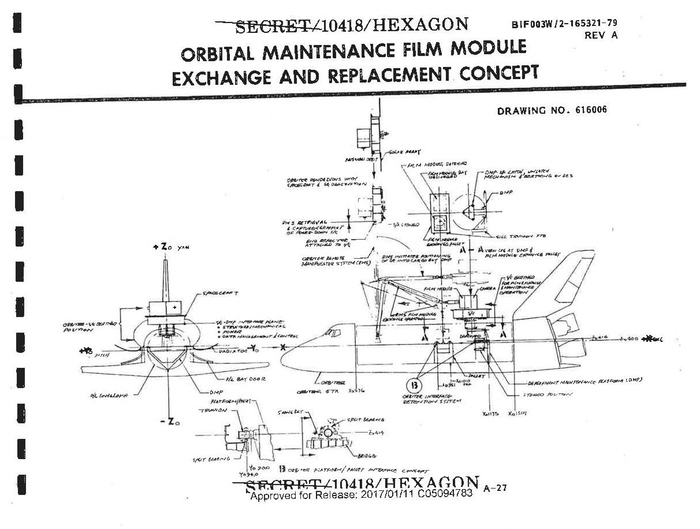 |
The WASP studies concluded that three sets of hardware would be required, including two flight payloads and a qualification payload that could be refurbished for flight. The NRO also developed a notional WASP acquisition plan that would have requested proposals in the second half of 1979 and started production in mid-1980, with first flight taking place by spring 1983.
HEXAGON in the payload bay
In December 1978, the NRO produced a mid-study briefing of a “Shuttle Transport System Panoramic Camera System Performance Analysis Study.” That study evaluated mounting a HEXAGON camera system based upon the seventeenth HEXAGON vehicle—which had just started building and therefore represented the most recent version—mounted on a pallet in the shuttle’s payload bay. The HEXAGON camera system consisted of two cameras with 1.52-meter (60-inch) focal lengths and 51-centimeter (20-inch) apertures. The system would carry 43,282 meters (142,000 feet) of film for each camera, with four takeup reels. It would also carry a HEXAGON Solid-State Stellar (S3, or “S-cubed”) sensor mounted in combination with the panoramic camera. The S3 would provide metric coverage capability, meaning precisely locating objects on the ground, a prerequisite for targeting them with nuclear missiles. The shuttle would fly 7- to 30-day missions with a perigee above 176 kilometers (95 nautical miles). It would fly up to 57-degree inclinations from Florida, and up to 97-degree inclinations—polar orbits—from Vandenberg in California.
The study assumed that by late 1984 or early 1985 such missions would take the place of the annual HEXAGON missions then planned through 1984. Test missions would start flying earlier. Three 21-day missions per year could achieve most current search coverage requirements. The primary mission would be “standing search,” with approximately 25 percent of the film load devoted to “special search.” But the mid-study briefing concluded that the system could only fulfill 57 percent of a “two month requirement” to revisit specific targets. One option was for another system, presumably the KH-11 KENNEN digital satellite, to pick up some of the slack for revisiting these targets, possibly in what the report referred to as “low conflict regions.”
The final report was concluded by May 1979 and provided more detail on the Panoramic Camera System. The PCS would be 5.2 meters (seventeen feet) long, weigh 4,990 kilograms (11,000 pounds), and require two kilowatts of power for operation. PCS operation would be independent of the spacecraft, it would be turned on and off and monitored from the Satellite Control Facility in Sunnyvale, California, where a large blue-painted building right next to the freeway was popularly known as the “Blue Cube.”
At the time, the study assumed that shuttle launches would start by the end of 1979, and Vandenberg launches would not be possible until mid-1983. In actuality, the first shuttle launch did not occur until April 1981 and the Space Launch Complex-6 shuttle launch facility at Vandenberg Air Force Base was not ready until 1986.
To maximize coverage during the time of year when the Soviet Union was under the least cloud cover, the launches would take place at regular intervals: February 13, June 15, and October 15. Like the mid-study report, the final report concluded that the PCS on the shuttle could not achieve the two-month requirement for “standing search clusters.” The report noted that “more frequent missions would have resulted in substantial over satisfaction of all requirements except the two-month and special requirements. Therefore, only three mission per year STS PCS operational concepts were considered in this study.”
The PCS was a generalized feasibility study. The next stage was known as the Shuttle Photographic Pallet Program, which would have used existing flight-qualified HEXAGON hardware mounted on a pallet inside the shuttle bay. The goal was to “complement/augment standing search requirements satisfaction [and] provide a resource to increase imagery flow in support of Strategic Arms Limitation Treaty monitoring, and serve as a gap filler as well as a backup for other systems.” It would be an interim program until the “Phase 2 operational system” was ready. The HEXAGON take-up design would be modified to serve as the film supply, providing a film load capacity of 24,384 meters (80,000 feet). “The pallet system will also incorporate a shroud to enclose the sensor subsystem for purposes of both security and shuttle environmental protection (acoustic, thermal, and contamination).”
At some point in 1978, the goal was for approval by February 1, 1979, with availability in late 1981. The first flight would last seven days and confirm the system’s capability. By 1982, the system would be available for twice-yearly flights. Notably, the name of the pallet for holding this equipment remains classified in recently-released documents, probably because it later found use in another program.
| The NRO also conducted an “STS Exploration Study” in March 1979 to define what intelligence missions the space shuttle could conduct, not just search, but all potential intelligence missions, and what value humans could provide for those missions. |
What is unclear is if the Phase 1 program would have used the existing development model camera for HEXAGON, or a new HEXAGON-derived camera. With the HEXAGON program slated to come to an end, the development model camera, which had been built in the mid-1960s and continuously updated by Perkin-Elmer over the years, was no longer needed to support HEXAGON except for trouble-shooting during missions. But it was a high-quality optical system that had been flight qualified late in the program. The camera project engineer, Phil Pressel, who wrote Meeting the Challenge, the Hexagon KH-9 Reconnaissance Satellite, the definitive book on the HEXAGON system and how it worked, and also has a blog on the HEXAGON, remembers being involved in a late-1970s project to evaluate a pallet for holding the HEXAGON development camera in the shuttle bay.
While the STS/PCS study was still underway, the NRO also conducted an “STS Exploration Study” in March 1979 to define what intelligence missions the space shuttle could conduct, not just search, but all potential intelligence missions, and what value humans could provide for those missions. The study looked at previous experience with the Manned Orbiting Laboratory, which had been canceled in 1969. It also looked at recent operational anomalies with both HEXAGON and GAMBIT vehicles to determine what possible functions humans could have performed in relation to them. The assessment concluded that a payload or mission specialist could have replaced electronic boxes during several recent problematic spacecraft missions such as the eleventh and fourteenth HEXAGON flights. The assessment also determined that a payload or mission specialist “could have substantially reduced the time required to recover from anomalous payload conditions” such as the first and third HEXAGON missions, and the forty-seventh and forty-eighth GAMBIT missions, which had all suffered glitches in orbit.
ZEUS ascending
By early 1979, the NRO had applied the code-name ZEUS to cover both the studies of putting the HEXAGON camera system on a pallet in the shuttle bay, along with the studies of developing entirely new camera systems. Whereas WASP was a proof-of-concept study and the Panoramic Camera System was a more refined study, ZEUS was a development program to prepare to produce hardware. “The ZEUS system will be STS optimized for launch economics, recovery and recycle, and payload vs. STS parameters,” a declassified NRO document stated. “The photographic hardware will utilize current technology in electronics, computers, software, and structural materials.” The palletized ZEUS option would be a fully integrated system, and it could use the on-board processing capabilities of the shuttle orbiter. It might also be equipped with a real-time or near-real-time system so that an operator inside the orbiter could maximize the performance of the camera system. The NRO anticipated that ZEUS would fly on 21-day shuttle missions, but acknowledged that the on-orbit lifetime of the shuttle orbiters had still not been determined.
In spring 1978, the NRO had funded four camera contractors—Itek, Perkin-Elmer, Eastman-Kodak, and Fairchild—to study the use of a new single camera (in contrast to HEXAGON’s two cameras) to obtain stereo imagery for both wide area search and mapping, charting, and geodesy. The studies indicated that the concept was feasible using a Single Camera Stereo (SCS) payload with an aperture of approximately 51 centimeters (20 inches), the same as HEXAGON, although the focal length was apparently less than the HEXAGON’s 1.52 meters (60 inches). The camera concepts would use existing film, but be capable of evolving to use a photo-conductive film for near-real time readout capability. Film was still the only method of storing the massive amounts of data gathered up by each sweep of the camera.
In October 1978, the NRO had initiated the SCS/Shuttle study to investigate flying a Single Camera Stereo on the shuttle. The plan was to start initial experimental flights on the shuttle as early as 1981 and achieve initial operating capability by 1983–1986. A free-flyer vehicle using photo-conductive film was conceived for 1986 and beyond. The NRO decided to pursue further study of only the Eastman-Kodak and Fairchild camera designs.
| The study also addressed the possibility of an “interim free flyer” that would consist of three satellites launched from the payload bay to operate in slightly different orbits, using film in their cameras, and unlike HEXAGON, they would not use reentry vehicles to send the film to Earth. |
The evaluation of the two camera designs indicated that the SCS could be built using existing technology. If launched from Florida, it could perform a 20-day mission. The SCS was relatively small and only took up a small portion of the payload bay, leaving enough payload capability to enable the shuttle to fly with another payload. For security purposes, NRO officials preferred that any other payload be a deployable military satellite, although the NRO also considered the possibility of flying with NASA shuttle bay payloads—but not those with foreign participants, like international Spacelab flights. If launched from Vandenberg, the mission would last 15 to 20 days, but would require a dedicated shuttle flight. The Florida-launched mission would provide significant coverage of 45 to 59 degree latitudes, but not higher latitudes, whereas a Vandenberg launch would provide coverage above 57 degrees latitude, but provide 25 to 50 percent less coverage of the lower latitudes than the Florida-launched mission. The report concluded that the Vandenberg missions were not attractive from either a cost or ground coverage standpoint.
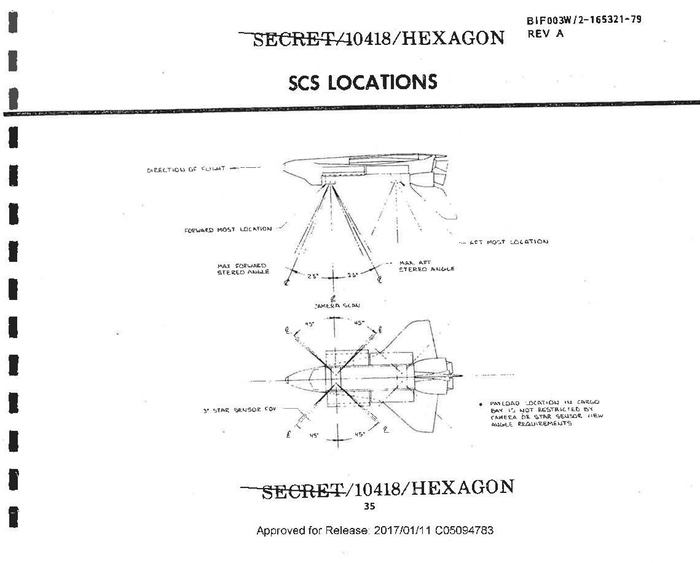 |
Although the pallet and SCS in the payload bay only weighed 2,268 kilograms (5,000 pounds), if the mission was to fly for twenty days this would require payload support equipment that weighed an additional 12,428 kilograms (27,400 pounds). For an operational program, the NRO would have to procure at least three full camera payloads, with two in ready condition for each launch. Camera refurbishment would take approximately 12 months, and how often the cameras had to be refurbished was an important factor determining how many payloads would be required.
The study also addressed the possibility of an “interim free flyer” that would consist of three satellites launched from the payload bay to operate in slightly different orbits, using film in their cameras, and unlike HEXAGON, they would not use reentry vehicles to send the film to Earth. The satellites would be retrieved by another shuttle approximately four months after launch.
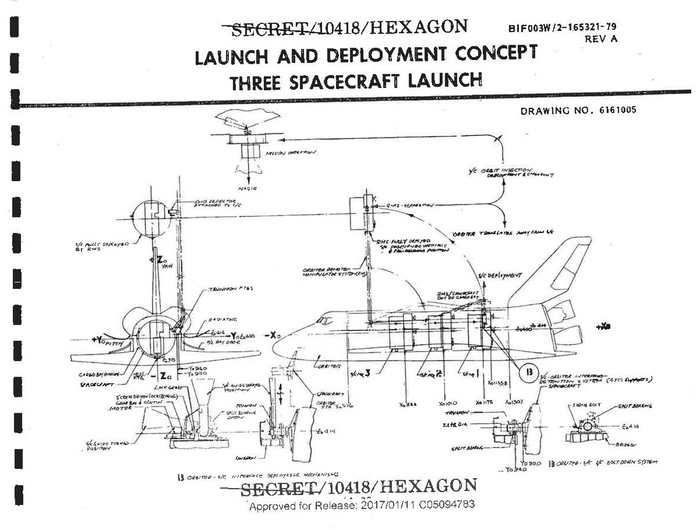 |
The study concluded that the two-month requirement for revisiting higher-priority target areas was difficult to achieve using the shuttle. Reaching this goal using Florida launches would require dedicated—and therefore expensive—space shuttle flights. The study’s final recommendations were that the NRO should pursue the pallet development and operations for both East and West Coast launches, they should delete the two-month target revisit and high latitude target coverage requirements for the interim free-flyer system, and they should continue technology developments for an advanced free-flyer. An advantage of the pallet system was that it could also be used to develop and test the technology for the advanced free-flyer by carrying it to orbit and operating it during shuttle missions.
The ZEUS cameras
According to the declassified documents, the intelligence community’s search requirements were no longer as stringent as they had been when HEXAGON was first developed. The SCS camera would provide ground resolved distance of 0.8 meters (31.5 inches) at nadir, i.e., looking straight down from a 278 to 333 kilometer (150 to 180 nautical mile) orbit. This was significantly lower resolution than HEXAGON. The declassified capabilities of HEXAGON are listed as 0.6–0.9 meters (24–36 inches), but a simple calculation of the HEXAGON’s operational altitude and camera power indicates that, under ideal situations, the spacecraft could do substantially better than the publicly released figures. The imaging swath would be 160 kilometers cross-track, with stereo convergence of 20 to 55 degrees.
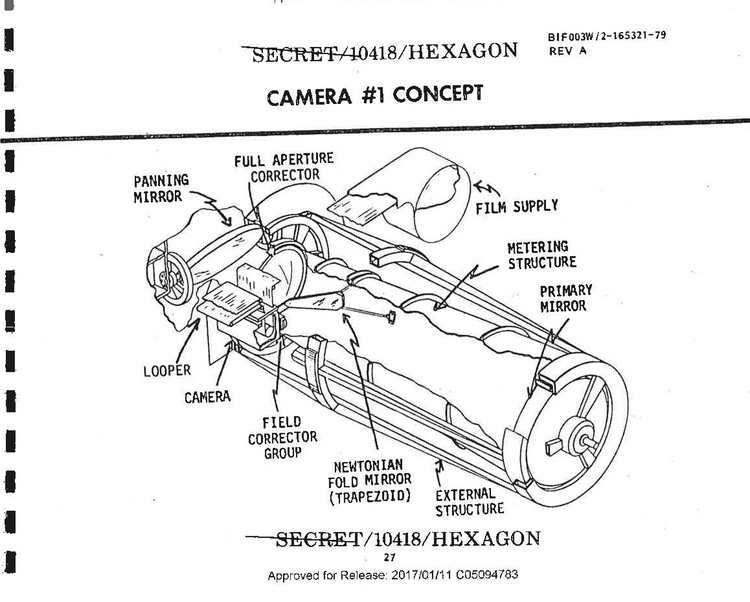 |
Eastman-Kodak proposed a camera using a Maksutov optical design, which included a folded optical path that bent the image back inside the camera barrel where other mirrors would focus the image. In contrast, Fairchild proposed a camera with a Petzval refracting design. The Fairchild camera used flat mirrors for bending the image into the camera, but the image focusing optics were refractive, with two sets of lenses to concentrate the image onto film that slid around the outside of the barrel containing the lenses.
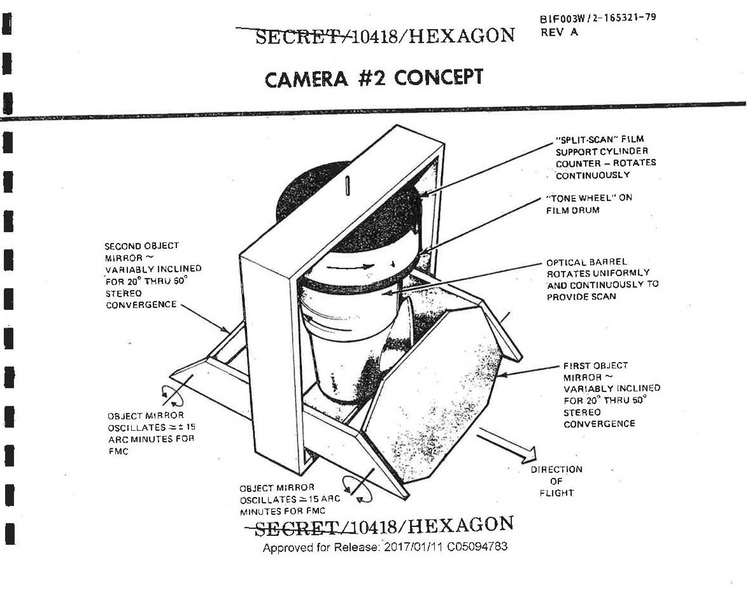 |
The study also looked at free-flyers using the two camera systems. The free-flyer satellite would weigh approximately 3,765 kilograms (8,300 pounds), with 227 kilograms (500 pounds) of film and 680 kilograms (1,500 pounds) of propellant. Each spacecraft would be disc-shaped, with two deployable solar panels on top.
| During the interview, Faga was asked about the 1978 decision to put future NRO payloads on the space shuttle. “We were uncomfortable with it,” Faga replied. |
One possibility for the interim free-flyer approach was to conduct on-orbit servicing, replacing the film load and fuel for the satellites. The shuttle would rendezvous with a free-flyer satellite, grab it with the Remote Manipulator System (i.e. the Canadarm), and bring it into the payload bay. It would then be attached to the deployable maintenance platform (DMP) developed for the Hubble Space Telescope, or another maintenance platform that NASA was developing for early shuttle flights. Astronauts would perform spacewalks to replace the film, or the entire spacecraft could be returned to Earth. But the study indicated that capture, servicing, and reflight were all relatively unknown options that could potentially be expensive. They would not really know until the shuttle started flying and demonstrating this capability.
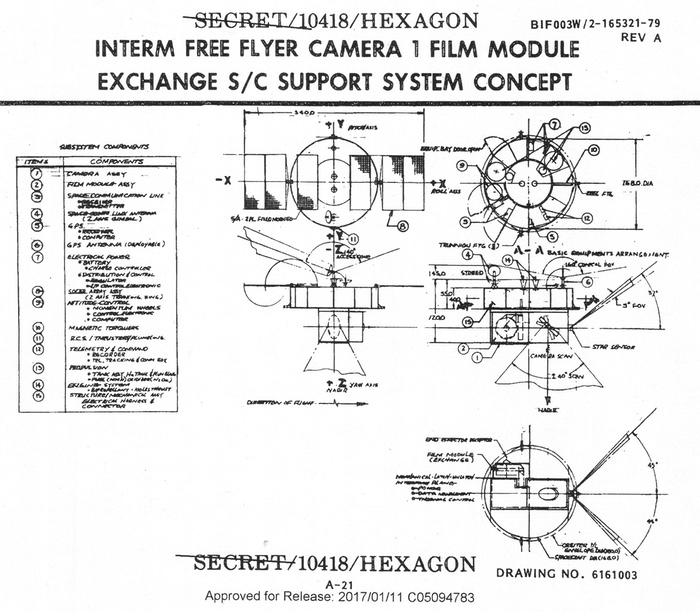 |
At some point the program also earned the title Shuttle Sortie Search System, and a declassified NRO document stated that, “This will be the first Shuttle-based as well as the first Shuttle-launched intelligence mission.” Initial test flights were scheduled for 1982–1984, with an optimized system launching in 1984 from Vandenberg.
The end of ZEUS
Martin Faga was the NRO director from 1989 to 1993 and had a long career in the intelligence community dating back to the 1970s. In November 1996, he was interviewed about his NRO experiences by NRO historian Gerald Haines. The interview was declassified in 2016. In the latter 1970s, Faga was serving as a staff member on the House Permanent Select Committee on Intelligence, where one of his responsibilities was keeping track of NRO developments, including ZEUS.
During the interview, Faga was asked about the 1978 decision to put future NRO payloads on the space shuttle. “We were uncomfortable with it,” Faga replied. “The decision really had been, to move that way, had largely been made even by the time the [HPSCI] committee started operations in late ’77. I recall that there was an idea that came along ’78, ’79, maybe ’80, of flying all of our area search missions using film cameras on shuttle missions. That would have had to be four to six missions a year of 21 days each. We thought that was crazy, and fought it off,” Faga said.
Hans Mark was the NRO director from August 1977 to October 1979, and Faga indicated that Mark was the primary advocate for ZEUS. “He had come from NASA,” Faga explained, “and had a strong disposition to support the shuttle. We just refused to authorize the programs that would have done that, and insisted instead that [KENNEN] be upgraded to take on the increased mission.” KENNEN was the NRO’s newly-operational photo-reconnaissance satellite. Unlike HEXAGON, and ZEUS, it converted its images to digital signals and relayed them to the ground via other satellites in very high orbits. The first KENNEN had been launched in late 1976 and the satellites had a lifetime of approximately three years, compared to 21-day space shuttle missions. But the low altitude limited in how much ground the satellite could see, and how much bandwidth was available for sending the images back to a ground station.
“It had become evident from lots of testimony from the community that [KENNEN] could support a higher data rate,” Faga explained in the interview. “And a good bit more information per day, good bit more imagery per day, could be derived from it, for some relatively inexpensive improvements. And we pushed in that direction.” Faga recalled a congressman on the committee pressing Hans Mark about the costs of flying multiple ZEUS missions on the shuttle. Faga did not remember Mark’s answer, but the House committee’s members were skeptical of the ZEUS system and, along with their Senate counterparts, they challenged Mark.
Faga did not say if congressional opposition killed ZEUS, but that skepticism, along with Hans Mark’s departure from the NRO to become Secretary of the Air Force, undoubtedly made it difficult for ZEUS’s remaining advocates to succeed in getting the program funded. There are no clear indications in the declassified record of when ZEUS was finally abandoned, but the declassified official history “The Hexagon Story” confirms that KENNEN (which it refers to as the “electro-optical system”) replaced HEXAGON in the search role.
Even though ZEUS was canceled and the NRO had decided on a replacement for HEXAGON, that did not mean that the HEXAGON was going quietly into the good night.
Next: Part 3, Everything old is new again: retrieving the remaining HEXAGONs with the space shuttle.
